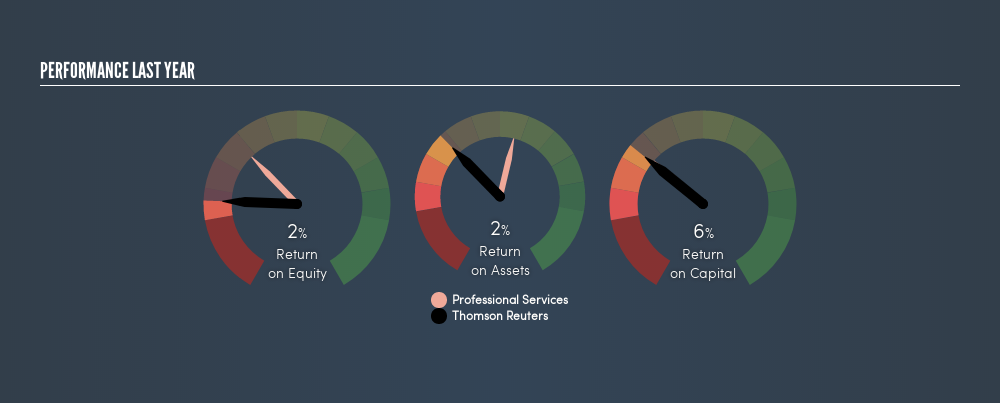- Canada
- /
- Professional Services
- /
- TSX:TRI
Thomson Reuters Corporation (TSE:TRI) Might Not Be A Great Investment
Today we'll evaluate Thomson Reuters Corporation (TSE:TRI) to determine whether it could have potential as an investment idea. Specifically, we're going to calculate its Return On Capital Employed (ROCE), in the hopes of getting some insight into the business.
First up, we'll look at what ROCE is and how we calculate it. Next, we'll compare it to others in its industry. And finally, we'll look at how its current liabilities are impacting its ROCE.
Return On Capital Employed (ROCE): What is it?
ROCE measures the amount of pre-tax profits a company can generate from the capital employed in its business. Generally speaking a higher ROCE is better. Ultimately, it is a useful but imperfect metric. Renowned investment researcher Michael Mauboussin has suggested that a high ROCE can indicate that 'one dollar invested in the company generates value of more than one dollar'.
So, How Do We Calculate ROCE?
The formula for calculating the return on capital employed is:
Return on Capital Employed = Earnings Before Interest and Tax (EBIT) ÷ (Total Assets - Current Liabilities)
Or for Thomson Reuters:
0.059 = US$859m ÷ (US$17b - US$2.5b) (Based on the trailing twelve months to December 2018.)
Therefore, Thomson Reuters has an ROCE of 5.9%.
See our latest analysis for Thomson Reuters
Does Thomson Reuters Have A Good ROCE?
ROCE is commonly used for comparing the performance of similar businesses. In this analysis, Thomson Reuters's ROCE appears meaningfully below the 8.3% average reported by the Professional Services industry. This performance is not ideal, as it suggests the company may not be deploying its capital as effectively as some competitors. Separate from how Thomson Reuters stacks up against its industry, its ROCE in absolute terms is mediocre; relative to the returns on government bonds. Investors may wish to consider higher-performing investments.

Remember that this metric is backwards looking - it shows what has happened in the past, and does not accurately predict the future. Companies in cyclical industries can be difficult to understand using ROCE, as returns typically look high during boom times, and low during busts. ROCE is only a point-in-time measure. What happens in the future is pretty important for investors, so we have prepared a freereport on analyst forecasts for Thomson Reuters.
What Are Current Liabilities, And How Do They Affect Thomson Reuters's ROCE?
Current liabilities are short term bills and invoices that need to be paid in 12 months or less. Due to the way ROCE is calculated, a high level of current liabilities makes a company look as though it has less capital employed, and thus can (sometimes unfairly) boost the ROCE. To check the impact of this, we calculate if a company has high current liabilities relative to its total assets.
Thomson Reuters has total assets of US$17b and current liabilities of US$2.5b. Therefore its current liabilities are equivalent to approximately 14% of its total assets. This very reasonable level of current liabilities would not boost the ROCE by much.
Our Take On Thomson Reuters's ROCE
If Thomson Reuters continues to earn an uninspiring ROCE, there may be better places to invest. Of course, you might find a fantastic investment by looking at a few good candidates. So take a peek at this freelist of companies with modest (or no) debt, trading on a P/E below 20.
For those who like to find winning investments this freelist of growing companies with recent insider purchasing, could be just the ticket.
We aim to bring you long-term focused research analysis driven by fundamental data. Note that our analysis may not factor in the latest price-sensitive company announcements or qualitative material.
If you spot an error that warrants correction, please contact the editor at editorial-team@simplywallst.com. This article by Simply Wall St is general in nature. It does not constitute a recommendation to buy or sell any stock, and does not take account of your objectives, or your financial situation. Simply Wall St has no position in the stocks mentioned. Thank you for reading.
About TSX:TRI
Thomson Reuters
Operates as a content and technology company in the Americas, Europe, the Middle East, Africa, and the Asia Pacific.
Adequate balance sheet and fair value.
Similar Companies
Market Insights
Community Narratives




